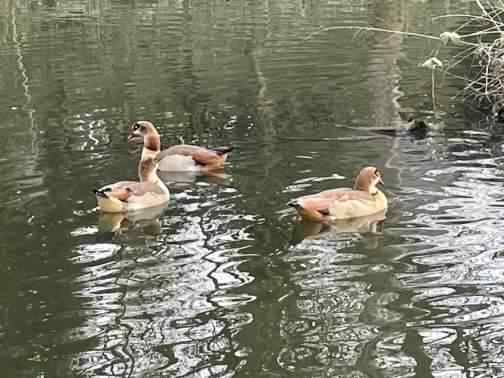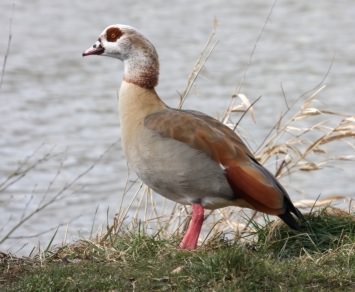
Photo ©
Click any photo for a larger image

Photo ©2008 - Andreas Trepte
Recordings ©2022 Simon Elliott

Photo ©
Click any photo for a larger image

Photo ©2008 - Andreas Trepte
Recordings ©2022 Simon Elliott
Egyptian Goose - Alopochen aegyptiaca
Family - Anatidae
Once considered sacred by the Ancient Egyptians, the Egyptian Goose is a native as its name suggests, of Egypt, the Nile valley and surrounding areas. They are a popular ornamental in bird collections elsewhere which have then become common in other areas worldwide from escapees, forming feral populations. Although called a Goose it is believed to be more closely related to the Shelducks and their relatives, and is placed with them giving rise to the English name, it is 63–73cm (25–29in) long. Males and females are identical in plumage with both having a conspicuous chestnut patch around the eyes, males are slightly larger and heavier. Plumage can vary in colouration with some birds tending greyer and others brown.
Vocalisations between male and females is different, the males having a hoarse quack, attracting mates with a noisy courtship display. The female has a noisier raucous quack that can be incessant when tending her young. They mate for life and both sexes are aggressively territorial towards their own species when breeding. Egyptian geese typically eat seeds, leaves, grasses and plant stems and occasionally they will eat invertebrates or other small animals. Widely found and locally abundant in sub-Saharan Africa excepting deserts and dense forests. It has spread to Great Britain, and much of eastern Europe where it has formed populations mostly derived from escaped ornamental birds. It is reported as also breeding in parts of the USA and New Zealand. Concerns over conflict with native species has led to restrictions on keeping them in Britain and Europe.
In the UK it is a non-native species found mainly to the east and on the Thames, with localised populations elsewhere. Being classified as non-native under the UK Invasive Alien Species Order 2019, they may be shot without special permission if they cause problems. In Europe, the species was added to the list of Invasive Alien Species of Union concern in 2017. The species apparently cannot be imported or bred, transported or intentionally released into the environment, and member states are obliged to try to eradicate the species. Ruddy Ducks (Oxyura jamaicensis) are also included in these restrictions.
Site design ©1999– Brickfields Country Park - Privacy -